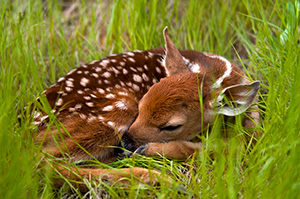Home → Fish & Wildlife → Wildlife → Living with Wildlife → Dealing with Orphaned or Injured Wildlife → Deer Fawns
You found a deer fawn all alone... now what?
Keep wildlife wild. If you care, leave them there.

It is not uncommon to find a young fawn all alone in the spring and early summer. The nutrient profile of a mother’s milk enables a doe to leave her fawn for many hours while she feeds on her own to sustain the demands of nursing. Until the fawn is strong enough to keep up and come along, an adult doe may hide her fawn in the forest floor leaves, returning two or three times a day to nurse. During this time, the fawn is protected from predators by its camouflaged coat and its lack of scent.
Most fawns found alone are not orphans and should be left alone in the wild. Fawns raised by their mom have a significantly higher chance at survival. In fact, several studies have shown that captive-raised fawns have an 85% chance of mortality within three months of being released. Humans simply can’t do the job that mom was intended to do!
It is always best to leave fawns alone, and you should never attempt to feed them under any circumstances. Repeated visits to a fawn can draw the attention of predators, and could discourage the mother from returning. Leave the area, and ensure pets stay away.
To determine if the fawn is truly injured or orphaned, please use the guide below.

View text version of fawn chart
Is the fawn critically injured?
Signs to look for:
- Serious bleeding
- Open wounds
- Broken bones
If the fawn does not exhibit those signs, the fawn does not need help.
Does leave their fawns unattended most of the time, only returning 2-3 times per day to nurse.
Fawns rely on camouflage to stay safe until they are strong enough to keep up. The mother will return if you give her space. Keep your distance, make sure children do the same, and bring pets indoors.
If the fawn does exhibit signs of being critically injured:
Carefully place the fawn in a secure pet carrier or box. Put the fawn in a warm, dark, and quiet place away from pets and children. Immediately contact Maine Department of Inland Fisheries and Wildlife to be connected with a wildlife biologist or game warden who can provide instructions. Never feed or attempt to rehabilitate a fawn yourself. Only licensed rehabilitators have the training to safely and legally care for injured wildlife.
Is the fawn truly orphaned?
Signs to look for:
- A large amount of fly eggs and/or ticks (some is normal)
- Weakness, lying on its side with legs splayed, unable to lift head
- Calling non-stop for hours
- Found in close proximity to a deceased doe
What to do if you believe the fawn is truly orphaned:
Before taking action, immediately contact Maine Department of Inland Fisheries and Wildlife to be connected with a wildlife biologist or game warden who can confirm the need for rescue and provide instructions. NEVER feed or attempt to rehabilitate a fawn yourself. Orphaned wildlife can only be legally and safely cared for by licensed wildlife rehabilitators.
Before taking action, immediately contact Maine Department of Inland Fisheries and Wildlife to be connected with a game warden or wildlife biologist. If necessary, the game warden or wildlife biologist will provide instructions. Do NOT move the animal unless directed to by a wildlife professional.
To reach a Game Warden 24-hours a day, please contact the dispatch center nearest you:
Augusta: 1-800-452-4664
Bangor: 1-800-432-7381
Houlton: 1-800-924-2261
To contact a wildlife biologist, please contact the appropriate regional office.
Can you S.P.O.T. a fawn in need of help?
SOUND. It is normal for fawns to call occasionally while their mom is away for up to 12 hours at a time, but near constant calling all day is a sign that they may have been orphaned.
PARASITES. It is normal for fawns to have some ticks. Their mom will groom them the next time she checks in. A fawn may be an orphan if you notice large amounts of fly eggs or maggots, or if the fawn's eyes are swollen shut due to numerous ticks on the face and ears.
OUTSTRETCHED. A normal resting position for a hiding fawn is sitting with their legs tucked in close to or under their body. A weak or dehydrated orphaned fawn may rest with their legs splayed, unable to stand or lift their head.
TRAUMA. Minor injuries are likely to heal on their own without intervention but life-threatening injuries such as serious bleeding or broken bones are a reason for rescue.